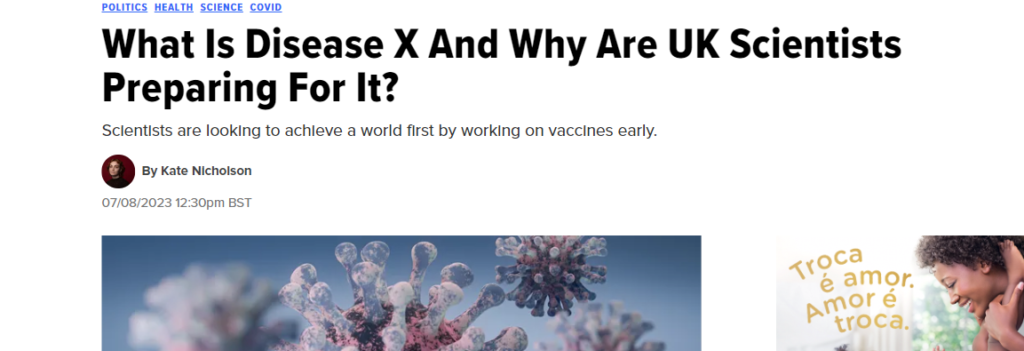the health strategist
knowledge platform
Joaquim Cardoso MSc.
Chief Research Officer (CSO), Chief Editor
Chief Strategy Officer (CSO) and Senior Advisor
August 8, 2023
What is the message?
“Disease X” represents an imminent challenge in the realm of public health due to the evolving nature of pathogens and the increasing risk of pandemics.
UK scientists are at the forefront of preparedness efforts, working to develop vaccines and therapeutics in record time to effectively respond to emerging threats.
Their research and collaboration underscore the urgency of anticipating and mitigating the impact of future pandemics.
Key takeaways:
- “Disease X” represents an unidentified potential disease that could pose a threat to human health in the future. This term encompasses various animal viruses that scientists have identified as potential sources of pandemics.
- The increased likelihood of future pandemics is attributed to climate change, which causes shifts in animal habitats and leads to increased human interaction with new pathogens.
- Among the potential candidates, bird flu is currently under close scrutiny due to its recent outbreak and transmission to mammals, including humans.
- The UK is taking proactive measures to prepare for such pandemic-inducing pathogens. A team of over 200 scientists at Porton Down, a high-security laboratory operated by the UK Health Security Agency (UKHSA) in Wiltshire, is working on a “100 Days mission.”
- This mission aims to develop a vaccine within 100 days of identifying a new pathogen capable of triggering a pandemic—a feat that has not been achieved before.
- The lab’s expertise extends to researching potent viruses and bacteria, including Ebola, and assessing the efficacy of vaccines against emerging variants.
- Collaboration with the pharmaceutical industry, scientists, and doctors is central to their efforts. The goal is to be prepared in case a new pathogen emerges. While the ambition of the 100-day target is high, it is deemed feasible for some viruses.
- UKHSA’s chief, Professor Dame Jenny Harries, emphasizes the importance of both prevention and response. They are actively developing vaccines and therapeutics to combat potential threats and are motivated by the understanding that another major public health incident may not be a century away.
- The scientists at Porton Down have already achieved success by creating the world’s first vaccine against Crimean-Congo haemorrhagic fever—a disease spread by ticks with a 30% fatality rate. Early stage clinical trials are underway for the vaccine, involving 24 volunteers who will test its effectiveness.
DEEP DIVE

What Is Disease X And Why Are UK Scientists Preparing For It?
Kate Nicholson
August 7, 2023
Scientists are already preparing the UK for a potential pandemic triggered by the mysteriously named Disease X.
While it may sound alarming, this is good news – and could result in a historic moment for healthcare. Here’s what we know so far.
What is Disease X?
This is just a name for any subsequent disease which could hit humans next, it’s not a specific illness just yet.
That’s because it’s not yet clear which of the animal viruses identified by scientists as potential threats could cause a pandemic.
But the likelihood of there being another pandemic is higher than it used to be, due to climate change. Animals are moving habitats due to shifting temperatures, which means humans are more likely to interact with them and pick up new diseases.
What is most likely to become Disease X?
Scientists have their eye on bird flu right now.
At least 30,000 seabirds died of the disease so far this summer, according to the Royal Society for the Protection of Birds, following the outbreak of a new strain.
What is Disease X?
This is just a name for any subsequent disease which could hit humans next, it’s not a specific illness just yet.
That’s because it’s not yet clear which of the animal viruses identified by scientists as potential threats could cause a pandemic.
But the likelihood of there being another pandemic is higher than it used to be, due to climate change. Animals are moving habitats due to shifting temperatures, which means humans are more likely to interact with them and pick up new diseases.
What is most likely to become Disease X?
Scientists have their eye on bird flu right now.
At least 30,000 seabirds died of the disease so far this summer, according to the Royal Society for the Protection of Birds, following the outbreak of a new strain.
It appears to have spread to some mammals, too.
Four humans contracted a mild infection in the UK early this year. Health agencies are still monitoring people who work with birds right now in case it starts to spread quickly among humans.
How are scientists preparing for potential pandemic-inducing pathogens?
A team of more than 200 scientists are working in a secretive, high-security lab, called Porton Down in Wiltshire, run by the UK Health Security Agency (UKHSA) on a “100 Days mission”.
It’s part of a global effort to create a vaccine within 100 days of a new pathogen which could trigger a pandemic – which would be a world first.
The development of the Covid vaccine was exceptionally fast, but it still took a year (as opposed to the usual five to 10 years).
Porton Down is also one of just a few labs around the world which has the facilities to research potent viruses and bacteria, like Ebola.
The site was previously focused on Covid and testing the effectiveness of vaccines against new variants.
Now, they also research high-risk pathogens like bird flu, monkeypox and new Covid variants, known infections which are evolving (and developing antibiotic-resistance) as well as something unknown – just as Covid once was.
Working with pharmaceutical industry, scinetists and doctors, they also try to test the effectivness of a vaccine.
UKHSA chief, Professor Dame Jenny Harries, told Sky News that the team are trying to prepare in case a new pathogen breaks through.
She said: “Hopefully, we can prevent [a pandemic]. But if we can’t and we have to respond, then we have already started developing vaccines and therapeutics to crack it.”
Touching on the 100-day target, she added: “This is a really high ambition. But for some viruses, it is definitely possible.”
She also told BBC News: “We say it [Covid] was the biggest public health incident for a century, but I don’t think any of us think it’ll be a century before the next.”
Have they had any success so far?
The scientists have already created the world’s first vaccine against Crimean-Congo haemorrhagic fever.
It’s spread by ticks and has a fatality rate of 30% and has been detected in Europe, and could continue spreading due to climate change.
But, the site now has early stage clinical trials starting for a vaccine and have 24 volunteers who will try out the vaccine.
Mentioned names
Kate Nicholson (reporter for the Huffington Post UK)
Professor Dame Jenny Harries (UKHSA chief)
Originally published at https://www.huffingtonpost.co.uk.











